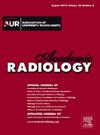Use of Intravoxel Incoherent Motion Diffusion-Weighted Imaging to Assess Mesenchymal Stromal Cells Promoting Liver Regeneration in a Rat Model
IF 3.9
2区 医学
Q1 RADIOLOGY, NUCLEAR MEDICINE & MEDICAL IMAGING
引用次数: 0
Abstract
Rationale and Objectives
Mesenchymal stem cells (MSCs) have the potential to promote liver regeneration, but the process is unclear. This study aims to explore the therapeutic effects and dynamic processes of MSCs in liver regeneration through intravoxel incoherent motion (IVIM) imaging.
Animal model
70 adult Sprague–Dawley rats were randomly divided into either the control or MSC group (n = 35/group). All rats received a partial hepatectomy (PH) with the left lateral and middle lobes removed. Each group was divided into seven subgroups: pre-PH and 1, 2, 3, 5, 7, and 14 days post-PH (n = 5 rats/subgroup). Magnetic resonance imaging (MRI) was performed before obtaining pathological specimens at each time point on postoperative days 1, 2, 3, 5, 7, and 14. The MRI parameters for the pure diffusion coefficient (D), pseudodiffusion coefficient (D*), and perfusion fraction (PF) were calculated. Correlation analysis was conducted for the biochemical markers (alanine transaminase [ALT], aspartate transaminase [AST], and total bilirubin [TBIL]), histopathological findings (hepatocyte size and Ki-67 proliferation index), liver volume (LV) and liver regeneration rate (LLR).
Results
Liver D, D* , and PF differed significantly between the control and MSC groups at all time points (all P < 0.05). After PH, the D increased, then decreased, and the D* and PF decreased, then increased in both groups. The hepatocyte Ki-67 proliferation index of the MSC group was lower on day 2 post-PH, but higher on days 3 and 5 post-PH than that of the control group. Starting from day 3 post-PH, both the LV and LLR in the MSC group were greater than those in the control group (all P < 0.05). Hepatocytes were larger in the MSC group than in the control group on days 2 and 7 post-PH. In the MSC group, the D, D* , and PF were correlated with the AST levels, Ki-67 index and hepatocyte size (|r| = 0.35–0.71; P < 0.05). In the control group, the D and D* were correlated with ALT levels, AST levels, Ki-67 index, LLR, LV, and hepatocyte size (|r| = 0.34–0.95; P < 0.05).
Conclusion
Bone marrow MSC therapy can promote hepatocyte hypertrophy and prolong liver proliferation post-PH. IVIM parameters allow non-invasively evaluating the efficacy of MSCs in promoting LR.
利用体内相干运动扩散加权成像评估间充质基质细胞在大鼠模型中促进肝脏再生的作用
理由和目标:间充质干细胞(MSCs)具有促进肝脏再生的潜力,但其过程尚不清楚。本研究旨在通过体外非相干运动(IVIM)成像探讨间充质干细胞在肝脏再生中的治疗效果和动态过程:70只成年Sprague-Dawley大鼠被随机分为对照组或间叶干细胞组(n = 35/组)。所有大鼠均接受肝部分切除术(PH),切除左侧和中间肝叶。每组又分为七个亚组:肝切除术前、肝切除术后 1、2、3、5、7 和 14 天(n = 5 只/亚组)。在术后第 1、2、3、5、7 和 14 天的每个时间点,在获取病理标本前进行磁共振成像(MRI)检查。计算了纯扩散系数(D)、假扩散系数(D*)和灌注分数(PF)的磁共振成像参数。对生化指标(丙氨酸转氨酶[ALT]、天冬氨酸转氨酶[AST]和总胆红素[TBIL])、组织病理学结果(肝细胞大小和 Ki-67 增殖指数)、肝脏体积(LV)和肝脏再生率(LLR)进行了相关分析:结果:在所有时间点上,对照组和间充质干细胞组的肝脏D、D*和PF均有显著差异(均为P 结论:骨髓间充质干细胞治疗可促进肝脏再生:骨髓间充质干细胞治疗可促进肝细胞肥大,延长肝脏在PH术后的增殖时间。IVIM参数可对间叶干细胞促进肝脏肥大的疗效进行无创评估。
本文章由计算机程序翻译,如有差异,请以英文原文为准。
求助全文
约1分钟内获得全文
求助全文
来源期刊

Academic Radiology
医学-核医学
CiteScore
7.60
自引率
10.40%
发文量
432
审稿时长
18 days
期刊介绍:
Academic Radiology publishes original reports of clinical and laboratory investigations in diagnostic imaging, the diagnostic use of radioactive isotopes, computed tomography, positron emission tomography, magnetic resonance imaging, ultrasound, digital subtraction angiography, image-guided interventions and related techniques. It also includes brief technical reports describing original observations, techniques, and instrumental developments; state-of-the-art reports on clinical issues, new technology and other topics of current medical importance; meta-analyses; scientific studies and opinions on radiologic education; and letters to the Editor.
 求助内容:
求助内容: 应助结果提醒方式:
应助结果提醒方式:


